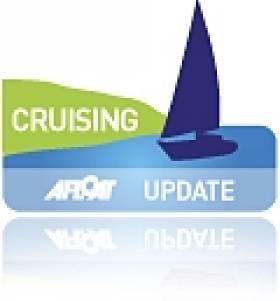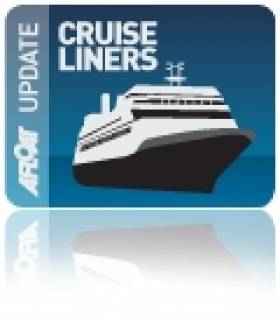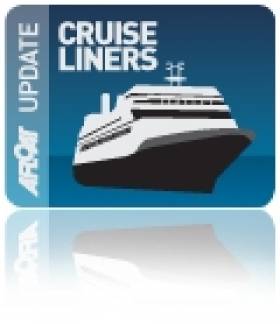Displaying items by tag: Superyachts
#Superboats – Having spent a week visiting Dun Laoghaire Harbour, the 46m superyacht Christopher that dwarfed the local 500 plus craft and several larger craft currently taking part in the Round Ireland race departed today and follows the anchorage of 37m motoryacht Katrion to the secluded waters off Glengariff, writes Jehan Ashmore.
Such large-sized and luxuriously appointed leisure-vessels visiting Irish waters, reflects not only the high-season, but also demonstrates the appeal of our wonderful scenic cruising grounds where the role of marina's and suitable sheltered seas benefit visitor alike and the local economy.
Christopher, a dark-bull hulled ketch from the design of Ron Holland cannot be easily forgotten even when witnessed in static mode moored alongside an outer-lying berth within Dun Laoghaire Marina.
The Cayman Islands flagged vessel was berthed close to the customs cutter, RCC Suirbheir, where she and her sister, RCC Faire are relatively frequent callers to the marina.
As for the motoryacht, Katrion, the white hulled 400 tonnes vessel launched from Feadship, a leading Dutch specialist of such luxurious leisure boats yesterday anchored off Glengariff having called as reported to Cork City Marina. Likewise her sheer size made an impact along local Leeside craft.
As previously alluded the 10-guest capacity visitor also flying the flag of the these Caribbean islands was due to discover the delights of Dingle, from where Katrion departed for Glengariff.
This she did as the vessel departed Dingle yesterday and took the passage to Glengariff along the spectacular rugged Kerry and Cork coastlines. This included a call to Knightstown, Valentia Island only accessible from the northern approaches due to the low-lying bridge linking the mainland at Portmagee.
Later the motoryacht made a transit through Dursey Sound before heading for her current attractive anchorage in Bantry Bay.
Glengariff is to welcome a considerably larger leisure seeker in the form of the 190m cruiseship Amadea due next month. As previously reported, there are seven callers scheduled this season, with the Phoenix Reisen operated ship to make a repeat call.
Beforehand another caller is expected the eye-catching cruise tall-ship, Club Med 2 due in September.
Yacht Market Gets A Boost As British Buyers Splash The Cash
#TradeNews - Yacht sales are on the upswing in Britain, with one superyacht broker reporting five deals in a single week for a total of a whopping £32 million (€39.9 million), according to Mail Online.
While mega-rich elites in the Middle East made up the bulk of the buyers during the lean years of the recession, now the western market is re-emerging - with the latest sales going to a German, an American and two wealthy Brits.
The new buyers, from brokerage Edmiston, are following the trail blazed by F1 mogul Eddie Jordan, who recently took the keys to his 155-foot superyacht that was revealed earlier this year by manufacturer Sunseeker.
And all this is in addition to a reputed 15% rise in luxury yacht charters, fuelling an insatiable appetite for opulence on the waves.
Mail Online has much more no the story HERE.
#MotorYacht - A striking looking Maltese flagged luxury charter motoryacht Lauren L, arrived this morning into Dublin Port to berth opposite the Poolbeg Yacht & Boat Club marina, writes Jehan Ashmore.
The 2,991 tonnes vessel built in Germany by the Cassens Werft shipyard, firstly began a career as a cruisehip. Under the name Sun Bay II, she made her debut season cruising in European waters and where she made a call to Dun Laoghaire Harbour, berthing alongside the ferry terminal at St. Michael's Wharf.
Under her current role, Lauren L as a charter yacht, she is able to host cocktail parties for up to 150 guests and overnight accommodation for 48 guests and all in the lap of luxury.
Features of the near 90m long vessel includes a conference room and centre, library, lido bar as well as a formal dining room plus a bow-mounted helicopter pad to shuttle guests to and fro.
Lauren L has a crew of 32 and she has worked in destinations such as the Cannes Film Festival. To charter the luxury motoryacht for a single week, this will set you back a mere €695,000, so get that lotto ticket!
She is approximately twice the size of the 52 passenger capacity cruisehip Quest, which called twice last year to Dun Laoghaire Harbour, where the port resumed in bringing this sector back after a break of more than a decade.
Next week, Dun Laoghaire Harbour looks forward in welcoming the giant 2,620 passenger liner Queen Mary 2. The Cunard Line 151,400 tonnes flagship will be making her maiden 'Dublin Bay' call with an anchorage call offshore of the harbour.
Rob Doyle Launches New Design Company
#Trade - Kinsale-based yacht designer Rob Doyle has announced the 'takeover' of the staff and offices of Ron Holland Design.
According to Superyacht Times, the 42-year-old issued a statement on Wednesday (27 March) outlining the changeover to his new yacht design, naval architecture and engineering business Rob Doyle Design, which is expected to take the previous company's work in a new direction with new design and refit projects.
"To have had the opportunity to work with Ron Holland over the past 18 years has been both a rare privilege and an eye opener as to what is possible," said Doyle.
"The experience I have gained and the lessons I have learnt make me want to explore more paths and develop further exciting projects with my team and build on Ron’s yacht design legacy."
Ron Holland, meanwhile, is still very much in the game - concentrating on his new centre of activity in Vancouver, where his company opened an office two years ago.
The mentor commented: "I look forward to continuing to collaborate with Rob on the projects that will carry the Ron Holland label and I also wish him all the best for the future of his own design firm and its projects."
Doyle has worked on a number of memorable projects under the Ron Holland brand, including the world's largest sloop Mirabella V and Ethereal, considered the most technically advanced superyacht yet developed.
Superyacht Times has more on the story HERE.
Superyacht Makes A 'Majestic' Entrance
#SUPERYACHT – The elegant streamlined luxury 60m/200ft motoryacht M.Y. Majestic is to dock in Dublin’s Port this evening, having departed Norway via Scottish waters, writes Jehan Ashmore.
The Caymen Islands registered 12-guest charter-yacht (view gallery) which has a crew of 15 to serve clients normally in the warmer climes of the Caribbean and Mediterranean.
On her visit to Dublin she is to moor midway alongside Sir John Rogersons Quay in the heart of the 'Docklands' quarter.
The motoryacht has a skylounge, which offers private vantage point for bird’s eye views. From here guests have the option to convert the lounge into a cinema with a 100-inch screen and a choice of more than 800 on-demand movie titles.
She was built in 2007 by Feadship, the same Dutch yard that completed the M.Y. Air which called to Cork in May. Majestic has two VIP staterooms, in which the stateroom on the lower deck takes up the full beam (10.9m/34ft) and is approached by its own guest lounge. The other accommodation is for five double en-suite cabins.
As to be expected of the millionaires’ yacht, there is an extensive array of leisure toys on board, be it through the use of two tenders (over 23ft), 3-man wave-runners, hobie kayaks, waterskis, wakeboards, scuba equipment facilities for 8 persons and for those snorkelling up to 12. All this is backed up by a Zodiac rescue boat, however for those not wanting to get their feet wet there’s the gym!
She is powered by a pair of CAT 3516 engines which generate 2000hp (1492kw) each, which deliver a cruising speed of 14knots, though if required this can increased to 16 knots.

































































